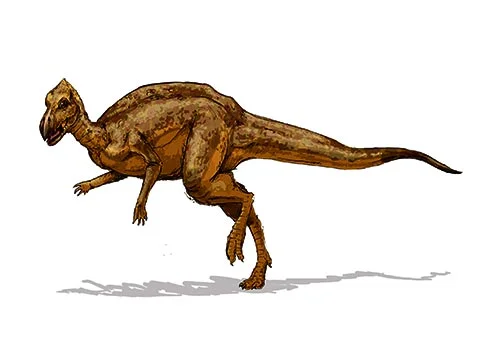Zalmoxes (After the Dacian deity Zalmoxis)

Zal-mocks-ees
David Weishampel, Coralia-Maria Jianu, Zoltan Csiki & David Bruce Norman - 2003
Herbivore
Estimated 4-5 meters long
Euornithopod
Z. robustus (type), Z. shqiperorum
Romania, Transylvania - Sânpetru Formation
Late Cretaceous, 68-66 million years ago
Zalmoxes Facts
Zalmoxes is a genus of small, herbivorous dinosaur that lived during the Late Cretaceous period, around 68-66 million years ago. It belongs to the family of dinosaurs known as the hadrosaurs, or duck-billed dinosaurs, which were some of the most common plant-eating dinosaurs of the time.
Zalmoxes was first discovered in Romania in the late 1990s, and was named after the Dacian deity Zalmoxis, who was worshiped by the ancient inhabitants of the region. The species name, robustus, refers to the dinosaur’s sturdy build.
Zalmoxes was a relatively small dinosaur, measuring about 4-5 meters (13-16 feet) in length and weighing around 400-500 kg (880-1100 lbs). It had a long, slender snout with a beak at the end for cropping vegetation, and hundreds of tightly packed teeth for grinding it up. Its limbs were relatively short and robust, and it likely moved on all fours.
One of the most interesting things about Zalmoxes is the fact that it is one of the few hadrosaurs known from Europe. Hadrosaurs are primarily known from North America and Asia, so the discovery of Zalmoxes in Romania provides valuable insight into the diversity and distribution of these dinosaurs.
Another notable feature of Zalmoxes is its unusual teeth. Unlike most hadrosaurs, which had hundreds of small, closely spaced teeth, Zalmoxes had larger, more widely spaced teeth. This suggests that it may have had a different feeding strategy than other hadrosaurs, perhaps specializing in tougher, more fibrous vegetation.
Overall, Zalmoxes is an interesting and important dinosaur for understanding the diversity of plant-eating dinosaurs in the Late Cretaceous period, and for shedding light on the evolution of these fascinating creatures.



